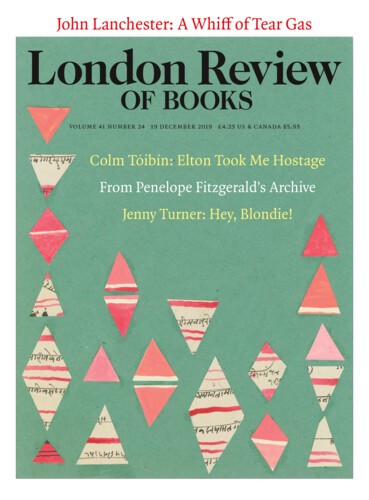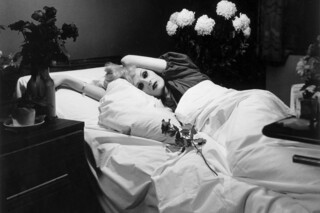The American photographer Peter Hujar once told a friend who was feeling unattractive: ‘As you’re walking along, say to yourself: I’m me.’ Hujar’s subjects seem to have heeded the same advice: they exhibit a self-possession tending to the monumental. You can see it in his 1981 portrait of the actor Madeline Kahn. Hujar posed her in an empty studio, wrapped in a hulking, dark coat: she looks like a solid black mass from which face, hands and legs emerge. The impression of solidity was partly a matter of form. Like Diane Arbus and Robert Mapplethorpe, Hujar created square, black and white images, typically using a Rolleiflex or the more sophisticated Hasselblad, plus tripod. The geometry of the square encourages a photographer to centre the subject and face it head on, turning unruly bodies and irregular scenes into fixed primary shapes. But this stillness also has an emotional force: much of the time, Hujar photographed people who were daring to hold themselves up, or trying to hold themselves together.
Peter Hujar: Speed of Life, currently on show at the Jeu de Paume in Paris (until 19 January), attests both to his work’s serene authority and the hectic New York scene from which it emerged. In their confident occupation of space and their abundance of drapery (sometimes Hujar just photographed the fabric), his portrait sitters can resemble figures by Nadar or Julia Margaret Cameron. Some of them were famous – William Burroughs, Brion Gysin, John Giorno – or soon to be: Hujar recorded successive generations of downtown scenesters, including Gary Indiana, Fran Lebowitz and Cookie Mueller. Even if he had been only a portraitist, Hujar’s work would be an essential document of queer life and aesthetics in New York between the early 1960s and the mid-1980s. It’s that and more besides.
Hujar was born in Trenton, New Jersey, in 1934. (The date puts him solidly between Arbus and Mapplethorpe, where he does and doesn’t belong.) At the High School of Art and Design in Manhattan, he was mentored by his English teacher Daisy Aldan, a former child actor and founder of the literary journal Folder. Hujar’s portrait of a playful, smiling Aldan appears early in the exhibition – Joel Smith, the curator, calls it ‘junior Avedonian’. In 1958 Hujar travelled to Italy with his boyfriend, and in 1963 he went back, this time on a Fulbright scholarship and with a new lover, the artist Paul Thek. Hujar was already making a name for himself, but his time in Palermo, where he photographed mummified friars and citizens in the Capuchin catacombs, seems to have enlivened his art from then on. The session lasted only about twenty minutes, but in these pictures Hujar is already rehearsing his later repertoire of ruminative headshots, supine dreamers and grinning group portraits.
The dead of Palermo would return, more than a decade later, in Hujar’s book Portraits in Life and Death. In between he worked as assistant to a commercial photographer, and, around the end of the 1960s, as a freelancer for fashion magazines and music companies. (In 1969 he photographed the shirtless Iggy Pop: a doe-eyed monument in the making.) Hujar’s photographs of East Village gay bohemia from this period – he rarely left, except to go to Fire Island – show a few competing styles. His collective portraits are school photos for the demimonde, and he continued to do them periodically, capturing each quick-change artistic era’s ‘tribe’. In the autumn of 1969, this documentation acquired a new political urgency when Hujar took a post-Stonewall photograph for the Gay Liberation Front: a small crowd of jubilant volunteers rushing his camera on 19th Street.
Then there are the individual portraits. Hujar worked frequently with Ethyl Eichelberger, a playwright, actor and drag performer who appears dressed as ‘Minnie the Maid’ in one photograph, as a tattooed nude in Hujar’s bare studio in another and then in close-up: shaven-headed and face deep in shadow. Ethyl never looks the same from one image to the next, a quality that recalls Claude Cahun, interwar pioneer of gender-fluid photographic travesty. In the early 1970s, Hujar photographed the Cockettes, a group of Californian performers who challenged the diva style of traditional drag with their hirsute countercultural masculinity. Hujar’s portrait Cockette John Rothermel in Fashion Pose, from 1971, has aspects of Cecil Beaton and Irving Penn – feathers, rouge and diamante – but it’s Rothermel’s haze of chest hair that really makes it. ‘I like people who dare,’ Hujar said.
That’s not to say his portraits lack vulnerability. In September 1973 he photographed the Warhol superstar Candy Darling on her deathbed (she asked Hujar to make a final portrait as a ‘farewell to her fans’). The pristine melodrama of the image – its elegant chiaroscuro – is largely a result of Hujar’s exacting attention to his prints. The hospital room seems miraculously lit. In a corner, seven white chrysanthemums loom out of the deepest black shadow, while in the foreground a vase of dark roses is silhouetted against a pale grey wall. In between, on the bed, Candy lies with arms flung over her head, doll-like, and her blonde hair floating on the pillow. There’s a single rose on the white sheet. Candy Darling on Her Deathbed is a formalist’s austere fantasy about Hollywood glamour and gothicism. It’s at once high camp and a real, death-defying self-assertion; they are the same thing, this photograph says. Other shots Hujar took that day show a more conventional frailty: Candy’s brittle hair and waxy skin, her downcast gaze, the label on the mattress.
Candy Darling didn’t appear in Portraits in Life and Death; perhaps in 1976 her portrait linked Hujar back too obviously to Warhol – he had been only fleetingly attached to the Factory set, appearing in four of the Screen Tests (Warhol called him ‘the boy that never blinked’). In Portraits, Hujar intersperses 12 of the Palermo photographs with portraits of Burroughs, Thek, John Ashbery, Divine, John Waters and others. Susan Sontag, whose reclining portrait is there too, wrote a preface for the book from her hospital bed, the night before her first surgery for breast cancer. They fell out after Sontag published On Photography the following year. Hujar was not alone in thinking she had no sense of photography as art. Avedon, he reported, had said: ‘You know, Peter – sometimes I think that Susan may be the enemy.’
Of course, Hujar’s problem with Sontag may have been that she failed to mention him in On Photography. He tended to begrudge other photographers their fame or success, even snubbing Beaton and Arbus out of spite. He reserved a special contempt for Mapplethorpe, who, Hujar liked to remind everyone, did not even print his own work. Mapplethorpe’s sleek, monochrome, square-format photographs display a radically simplified, and distinctly uptown, version of Hujar’s aesthetic. ‘Well, it looks like art,’ Hujar said. Even as his career stalled after Portraits, and he lived off cash advances on his credit cards, Hujar seemed to resist all efforts to gain him recognition. According to Lebowitz, ‘Peter was incapable of being nice to anyone who could do him any good.’
He didn’t publish another monograph after Portraits in Life and Death; at the Jeu de Paume, the few books shown alongside his prints are mostly posthumous catalogues. Around the end of 1980, Hujar met a young artist, David Wojnarowicz; they were briefly lovers and continued to collaborate on various projects. Hujar photographed Wojnarowicz’s mural paintings at New York’s disused piers, where gay men had found erotic community among the ruins. Wojnarowicz is the subject of Hujar’s starkly shadowed late portraits, and the pair scavenged the banks of the Hudson together for detritus to turn into art. Early in 1987, Hujar was diagnosed with Aids. The friends who came to help found he was penniless; to raise money, postcards of his work were licensed, including one featuring his Sontag portrait. When Hujar died later that year, Wojnarowicz photographed his body in luminous detail.
Send Letters To:
The Editor
London Review of Books,
28 Little Russell Street
London, WC1A 2HN
letters@lrb.co.uk
Please include name, address, and a telephone number.


